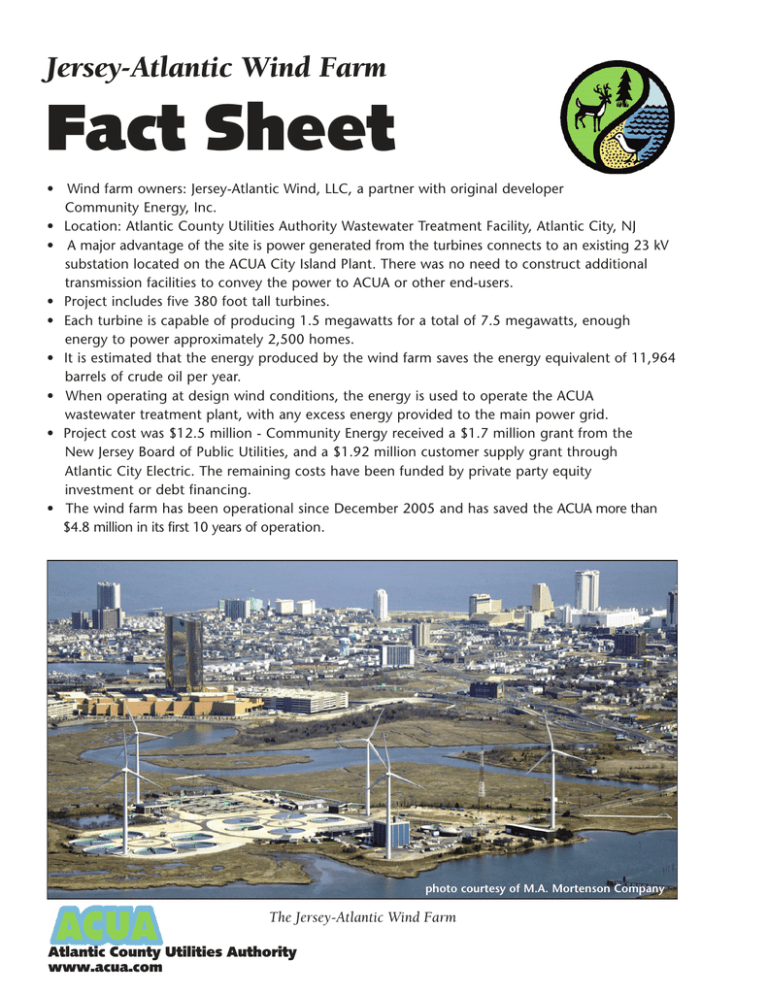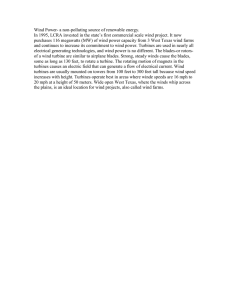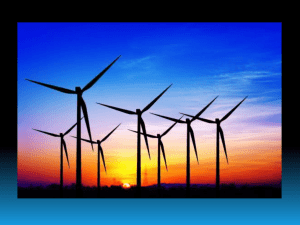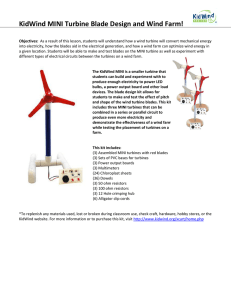Wind Farm Fact Sheet
advertisement

Jersey-Atlantic Wind Farm Fact Sheet • Wind farm owners: Jersey-Atlantic Wind, LLC, a partner with original developer Community Energy, Inc. • Location: Atlantic County Utilities Authority Wastewater Treatment Facility, Atlantic City, NJ • A major advantage of the site is power generated from the turbines connects to an existing 23 kV substation located on the ACUA City Island Plant. There was no need to construct additional transmission facilities to convey the power to ACUA or other end-users. • Project includes five 380 foot tall turbines. • Each turbine is capable of producing 1.5 megawatts for a total of 7.5 megawatts, enough energy to power approximately 2,500 homes. • It is estimated that the energy produced by the wind farm saves the energy equivalent of 11,964 barrels of crude oil per year. • When operating at design wind conditions, the energy is used to operate the ACUA wastewater treatment plant, with any excess energy provided to the main power grid. • Project cost was $12.5 million - Community Energy received a $1.7 million grant from the New Jersey Board of Public Utilities, and a $1.92 million customer supply grant through Atlantic City Electric. The remaining costs have been funded by private party equity investment or debt financing. • The wind farm has been operational since December 2005 and has saved the ACUA more than $4.8 million in its first 10 years of operation. photo courtesy of M.A. Mortenson Company The Jersey-Atlantic Wind Farm Atlantic County Utilities Authority www.acua.com Jersey-Atlantic Wind Farm Frequently Asked Questions 1. How tall is each turbine? Each wind turbine is 262 feet high and the tower has a diameter of 14 feet. The blades of the wind turbines are 120 feet long so that the total height from the ground to the tip of the blade is more than 380 feet, approximately the height of a 32-story building. 2. How fast do the blades turn? Depending on wind conditions, the blades turn at rates between 10 and 20 revolutions per minute. Considering the length of the blades with average wind speeds of 13 to 15 mph, the tips are traveling at 120 mph. At maximum wind speeds, the blade tips are spinning at an estimated 180 mph. 3. Why do some of the turbines turn and others do not? Wind velocity can vary up to five miles per hour across the site. Since the turbine’s blades are moved by the wind each turbine will move at a different rate. 4. How much do they cost? A private developer built the wind farm for a total project cost of $12.5 million. The ACUA will purchase electricity from the developer at a fixed rate of $.0795 per kilowatt hour for 20 years. 5. Can there be more than five? Due to the potential of blocking the wind, the site can only accommodate the current five wind turbines. 6. Why are there red lights on the top of the turbines? The Federal Aviation Administration requires red navigation lights on top of each wind turbine as a warning for aircraft in the area. 7. Could you use lights to make them visible at night? Lights attract insects and insects attract birds, therefore the wind turbines cannot be lit. 8. How much energy do they generate? When the wind is blowing more than 12 miles per hour, each wind turbine can produce 1.5 megawatts of electricity. At reduced wind speeds, electricity production decreases. When wind speed exceeds 45 miles per hour the turbines shut down to protect the machinery inside. It is estimated that the five wind turbines will produce enough power during the year to provide energy for 2,500 homes. 9. Who owns the wind farm? The wind farm is owned by Jersey-Atlantic Wind, LLC. 10. Do they make noise? The wind turbines are practically silent; however, on very humid days a slight “whoosh” can be heard. 11. Can someone visit? The wind farm is an industrial facility and therefore not open to the public. The ACUA opens the site to the public during its annual Earth Day festival and for “open house” tours Monday and Friday at 12 noon in July and August. Tours can be arranged for groups as large as 25 persons. Tour requests can be made online or by calling ACUA. 12. How much electricity do the turbines generate for the ACUA? The ACUA facility requires approximately 2.5 megawatts of power each day. When wind speeds Atlantic County Utilities Authority www.acua.com are above 12 miles per hour, all of the electricity required to run the plant can be generated by two of the five wind turbines. The remaining power is sold to the main power grid. The wind farm supplies approximately 60 percent of the electricity required by the plant on a annual basis. 13. How does it work? A weather station located on top of each of the wind turbines turns the nacelle, the small building at the top of the tower, facing into the wind. The turbine’s three blades pitch to maximize the speed at which the turbine spins. A shaft, attached to the hub of the blades, turns a gear box that is attached to a generator that processes the electricity. The electricity is then transported to the ground by wires, which are then attached to the electrical grid at the plant. Electricity not used by the ACUA runs backwards through the electric meter into the main power grid. 14. Can I buy electricity? Private and commercial electricity users can purchase wind generated power through their local electric company through the New Jersey CleanPower Choice Program. For more information on this New Jersey Board of Public Utilities program please visit www.njcleanenergy.com/cpc. 15. How much does it cost? The cost of wind generated power generally costs a little more than electricity generated by a fossil fuel plant; however, wind energy is both a clean and renewable source that does not contribute to climate change. 16. How much do wind turbines weigh? In the GE 1.5-megawatt model, the nacelle alone weighs more than 56 tons, the blade assembly weighs more than 36 tons, and the tower itself weighs about 71 tons - a total weight of 164 tons. http://www.wind-watch.org/faq-size.php Parts of a Wind Turbine U.S. Department of Energy Atlantic County Utilities Authority www.acua.com 03/16





